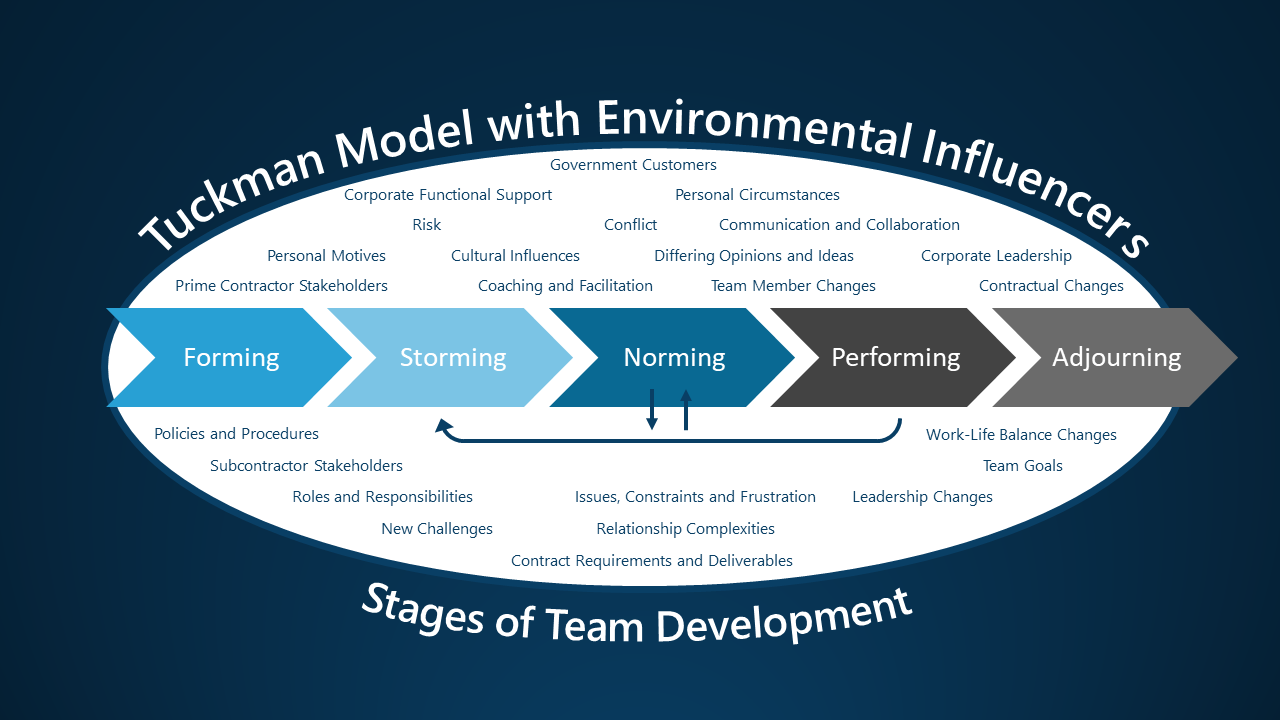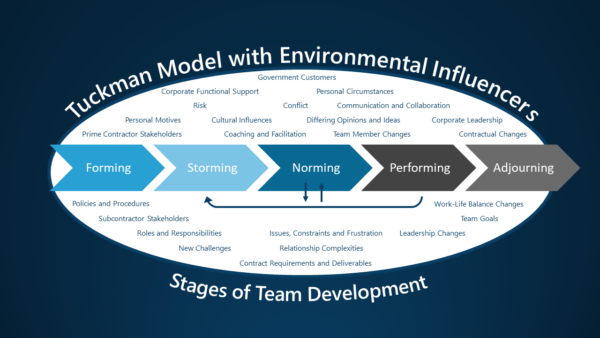Applying the Tuckman Model to Government Contracting

Applying the Tuckman Model to Government Contracting
In this post, Gene Chiappetta shares his thoughts on the Tuckman Model, a flexible framework that outlines the stages of team development. Gene is a program and project management expert who’s honed his skills over a 20-year career that includes work in both the public and private sectors, including over 12 years on government contracts. Gene has served in progressive leadership positions at various levels within Program Management Offices (PMOs). He is an experienced leader and quality-driven professional who is skilled in PMO operations, standing up PMOs, and managing and executing projects. Gene is a certified Project Management Professional from the Project Management Institute, holds an ITIL 4 Foundation Certificate and a Scaled Agile Framework (SAFe) 6 Practitioner Certificate, and is a Lockheed Martin LM21 Certified Green Belt in Lean Six Sigma. In his role at RELI Group, Gene serves as the Information Technology Mission Support Services Operations and Engineering Division program manager at RELI Group, supporting the Transportation Security Administration.

The Tuckman Model, widely known as the “forming-storming-norming-performing” four-stage model for team development and growth, was created by psychologist Bruce Tuckman in his 1965 paper titled “Developmental Sequence in Small Groups.” The fifth stage, “adjourning,” was added in 1977. The focus of the model is to contextualize the lifecycle of teams/groups and provide group dynamic insights and awareness to transform a newly formed group into a high-performing team.
The Tuckman Model is especially useful in government contracting because program, project and team leaders need to bring together prime and subcontractor team members with varied skillsets and diverse backgrounds to meet contract requirements and deliverables. I was first introduced to the Tuckman Model in a Project Leadership, Management and Communications course in 1998, and I’ve found it to be a valuable tool that’s stood the test of time. I’ve outlined the five stages of the Tuckman Model below, with actionable suggestions for leaders of all types and levels within each stage.
The Forming Stage
The Forming Stage of team development brings the group or team together, with information about the goals and objectives of the initiative provided by the leader. At this stage, the leader is actively engaged in answering questions and providing guidance and direction as team members learn about their roles and responsibilities, the purpose of the initiative, the scope of work, target deadlines, relevant issues, and cross-functional boundaries. In the Forming Stage, team members tend to be independent, excited and motivated, with positive expectations as they begin tackling their tasks. Team members typically start out on their best behavior in the Forming Stage.
In the Forming Stage, the leader needs to make sure team members are discussing the scope of work and assigning individual and group tasks. While this focus helps establish the procedures necessary to complete the work, it also helps identify any team members with apprehension or anxiety, and can bring challenges or frustrations to the surface. Team members will begin to test each other’s tolerance levels, including the leader; this is worth the risk of conflict as it is necessary for the group to advance through the stages of team development.
In my experience, I’ve found that setting up recurring meetings, establishing project schedules, tracking action items, and facilitating group discussions are excellent tools for bringing a new group together and transitioning them into a team. The recurring meetings set the pace and lets everyone know that this new initiative is a priority. In a project setting, having the team develop and maintain a schedule is critical for project success. Tracking action items is highly effective in helping the team focus on tasks that move the mission forward. Facilitation takes many forms, and the leader needs to observe the team to determine how best to facilitate. In addition to facilitating team meetings, I have often identified a need to talk individually with team members and direct them to talk with others to get things moving. I have also often scheduled calls with a few team members and facilitated the conversation to move specific team members forward. Often, I will be on the phone talking with a team member and spontaneously bring in others to join the call to keep the team on track.
On a government contract, it is especially vital that the leader facilitates communication and collaboration with all the project stakeholders – customers, corporate leadership, corporate functional support, the prime team, and the subcontractor team. These teams can be huge and complex, and navigating these relationships during the Forming Stage is essential for project success.
The Storming Stage
The Storming Stage of team development marks the end of the “honeymoon phase” for the newly formed group or team. As the team begins to execute, the excitement often transitions to frustration about roles, responsibilities, constraints and expectations, thereby impeding the team’s ability to focus on achieving its goals. Team members will challenge each other and the leader and engage in conflict, resulting in slow progress and even missed deadlines. There is often a lack of agreement between and among team members on various aspects of the mission.
The leader has a direct impact and influence on the duration of the Storming Stage. On my current contract here at RELI Group, I have spent time explaining the Tuckman Model to individual team members in conflict with each other in the Storming Stage. Just letting them know that storming is a normal part of the process was helpful. It took a few meetings and some behind-the-scenes coaching (my typical starting point), but I was able to get the conflicting team members to move past the Storming Stage.
In government contracting, the Storming Stage has the potential to be more prevalent because stakeholders from various contracting companies may be positioning themselves for change orders and new contract opportunities to increase revenue. Therefore, the leader of the group or team must watch and observe closely to recognize when the team or a subgroup has entered or reentered the Storming Stage. Once confirmed, the leader must act quickly to facilitate and/or guide the team out of the Storming Stage.
The Norming Stage
In the Norming Stage, the team begins to come together and work as a team. The team has learned to work with each other, listen to differing opinions and ideas, resolve conflicts and problems, agree on roles and responsibilities, establish achievable goals, develop processes, make decisions, complete tasks, and even have some fun. Team norms are being established to address the needs of diverse team members to meet established goals and contract deliverables. A sense of team pride starts to set in as the group begins to function as a cohesive unit.
I have found that once the group is operating like a team, it is a suitable time to get the team to focus on improving processes and task instructions because communication and teamwork has typically improved since the group was formed. Behind-the-scenes coaching of individuals is an effective tool to guide, advise and enable team members to collaborate and execute the plan. This also provides the leader with an opportunity to assess team members’ motivation levels as well as their follow-through skills to address issues, resolve problems and complete tasks.
Reaching the Norming Stage on a new government contract may take a little longer for the team due to the complexity of having team members from different contracting companies, each with their unique cultural and management influences. Regardless, having done the work in the Forming Stage and Storming Stage, a leader should be well-positioned to begin to step back and let the team grow in the Norming Stage.
The Performing Stage
The Performing Stage of team development happens when the team understands strategically what it is doing to execute the work. The team still takes overall direction from the leader; however, it is operating independently without day-to-day leadership, and team members should be addressing and resolving conflict, process and customer issues on their own. Satisfaction sets in as the team collaborates effectively to utilize the skills, talents and strengths of the collective group to meet project requirements and deliverables. During this Performing Stage, the leader checks the pulse of the team, reviews deliverables as needed, provides coaching and facilitation, and resets direction to accommodate the changing needs of government customers, as long as the requests are within the scope of the contract.
On my current program, I met weekly with one of our teams for over a year because our experienced team leader had an entirely new group to train on conducting specific complex work for this program. We covered actions, tasks, risks and issues with a cross-section of team members from systems engineering, data analysis and process support. There were also smaller meetings throughout the week that I would attend when requested. The cross-functional perspectives, communication and collaboration enabled the team to enter the Performing Stage quicker and successfully respond to our government customers’ requests in a timely manner.
As the team progressed, we eventually moved the meetings to a quick standup meeting early in the month and a longer meeting towards the end of the month where we reviewed actions, tasks, risks and issues. During this transition, I observed team members gaining more clarity on their roles and responsibilities and teaming up to solve problems based on their skillsets. The team members also began to focus on developing their individual skills to increase contributions to the mission and ensure customer satisfaction.
It is important to note that a team in the Performing Stage (or Norming Stage) can slip back into the Storming Stage when new team members are onboarded, existing team members depart, new process changes are implemented, or new contract deliverable requests stress the team. As a leader, I always increase my involvement when a new team member is being onboarded. I like to participate in early meetings to introduce the team member to their team leads, team members and customers. I will check in with the new team member and the various stakeholders and act as needed to ensure the team quickly gets back to the Performing Stage.
As a member on project, program, PMO and corporate teams over the years, I have observed that leadership changes often take teams back to the Storming Stage. This type of change in team dynamics impacts all groups from small project teams to the highest levels of program management, government agencies, and corporate c-suite executive teams. It is interesting to watch how individuals’ behaviors change as they position themselves to align with the new leader. Understanding the Tuckman Model and being aware of the state of the team has helped me during these times of leadership changes. I am better positioned to assess the new leader, the team and myself and make adjustments for my new reality, if I want to continue working in that employment situation.
The Adjourning Stage
The Adjourning Stage of team development occurs when the group prepares to disband. The leader needs to show a stronger presence during this stage – in my experience, some team members will be sad and disappointed that the work is ending, and others may lose focus and interest in the work. In government contracting, the final deliverables need to be delivered to fulfill contractual obligations, a key responsibility of the leader. If the team is adjourning from a specific project, the leader is often responsible for conducting a lessons-learned session, then preparing and submitting a summary document to close out the project.
Another challenge in government contracting is that team members may secure other jobs and leave the contract before the contract end date. This can pose significant challenges for the leader, team members and the company. Therefore, the leader needs to engage with team members during the Adjourning Stage and implement a strategy to address these challenges. Additionally, leaders should identify team members who want to stay with the company and secure a position on another government contract. At RELI Group, we have a good program/project manager network that promotes the placement of team members whose contracts are ending and want to stay with the company. During my time with RELI Group, I have transitioned a few employees from terminated government contracts onto my program.
The Tuckman Model is a very flexible framework that acknowledges reality – teams work through each stage at their own pace. It is widely used for explaining team and group behavior, and can be a valuable tool and reference point to help leaders, individuals and entire teams understand how they can accelerate progression through the stages of team development and become a high-performing team. Remember that teams will move back and forth between each stage to accommodate for personnel and team dynamic changes as well as new work challenges. It is important to note that leaders need to lead with flexibility and adjust their leadership styles within each stage to achieve and maintain the status of a performing team that delivers value to government customers.













